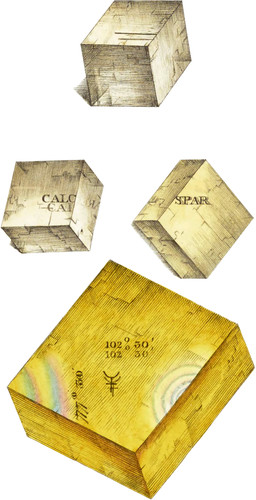 Enlarge
Enlarge
British Mineralogy
Crystallized Carbonate of Lime
- Class 2. Earth.
- Order 1. Homogeneous.
- Gen. 1. Lime.
- Spec. 2. Carbonate of lime.
- Spec. Char. Lime with carbonic acid effervesces with the stronger acids, and becomes quick-lime in a strong heat.
- Syn.
- Chaux aërée. Born, v. 1. 28.
- Kalk-stein. Emmerling, v. 1. 437.
- Aërated or mild calx. Kir. v. 1. 75.
- Chaux carbonatée. Haüy, v. 2. 127.
Div. 1. Crystallized.
- Syn.
- Spath calcaire. Born, v. 1. 107.
- Kalk spath. Emmerling, v. 1. 455.
- Foliated and sparry lime-stone. Kir. v. 1. 86.
- Calcareous spar. Bab. 7.
- Chaux carbonatée. Formes déterminables. Haüy, v. 2. 130.
Found chiefly in lime-stone rocks wherever they occur in Great Britain, as Derbyshire, some parts of Wales, Wiltershire, Devonshire, &c.
It is easily scraped with a knife; fracture in laminæ parallel to the nucleus, which is rhomboidal, its obtuse angles being 101° 30′, its acute 78° 30′. When sufficiently transparent, it gives a double refraction. It is never quite opaque, the colours are mostly white or lightish brown, sometimes reddish, seldom yellow or green, scarcely ever crimson, blueish, purple, or black.
Upper figure a nearly equal-sided fragment, to show the nucleus and the double refracting property, by being placed on a straight line, which appears displaced and doubled when viewed through the upper opposite face. The sides only reflect the object, for we cannot see a figure through the edges of the crystal.
Middle figures the same, somewhat thinner, placed on letters to show that the refraction divides towards the obtuse angles.
Lower figure, a rare fragment of fine yellow. The prismatic colours caused by the floaws are in the regular order of the rainbow: the brightness depends on the polish of the surfaces, and the closeness of the flaw, nearness to the surface, &c. The upper lighter fracture is paler, because the opaque white at the edge is in consequence of a blow in a direction contrary to the laminæ, which always bruises it. Please to read 101° 30′, 78° 30′, instead of what is engraved. It was thought proper to picture one face of each of these figures as near as might be to the measured angles* (the largest side of each). It may be fairly observed that, according to the rules of perspective, the other sides could not be seen; some rules may give way to perspicuity occasionally. Small objects cannot conveniently be observed by this rule, and very few people look perspectively, as it requires great nicety. These figures are intended to give a natural appearance to a general observer, who looking with two points of sight sees more of the subject. It is intended to use one point of sight thwere it should be found most eligible.
We must beg leave to refer our readers to Dr. W. H. Wollaston’s learned paper on the oblique refraction of the Iceland crystal (Phil. Trans. for 1802, part 2, p. 381), for an account of its refracting property.
- * A fragment placed by the angles will be found nearly to correspond with them.

